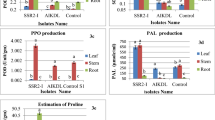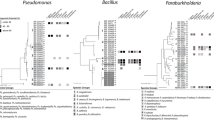Abstract
Sisal (Agave sisalana Perrine ex Engelm; Asparagaceae) bole rot is a devastating disease caused by Aspergillus niger Tiegh, which contributes to the decline of this crop in Brazil. Currently, there are no control measures available, but biocontrol is being investigated as a promising management strategy. Five previously selected bacterial isolates were identified by 16S rRNA sequencing as Paenibacillus sp. 512, Brevibacterium sp. 90 and Bacillus sp. 105, BMH and INV, and tested for their capacity to control bole rot in vitro and in field experiments. Individual bacterial isolates and their combinations significantly inhibited mycelial growth and spore germination of A. niger. In two independent field experiments, the application of isolates 512, 105, 90, INV, and 127 + INV reduced disease incidence to levels varying from 44 to 75%. Although there was no synergistic effect in their combined use, these bacteria have potential to be used against bole rot disease in the field.



Similar content being viewed by others
References
Aguiar FM, Michereff SJ, Boiteux LS, Reis A (2013) Search for sources of resistance to fusarium wilt (Fusarium oxysporum f. sp. vasinfectum) in okra germplasm. Crop Breed Appl Biotechnol 13:33–40
Athukorala SNP, Fernando WGD, Rashid KY (2009) Identification of antifungal antibiotics of Bacillus species isolated from different microhabitats using polymerase chain reaction and MALDI-TOF mass spectrometry. Can J Microbiol 55:1021–1032
Bakker MG, Schlatter DC, Otto-Hanson L, Kinkel LL (2014) Diffuse symbioses: roles of plant–plant, plant–microbe and microbe–microbe interactions in structuring the soil microbiome. Mol Ecol 23:1571–1583
Benoit I, van den Esker MH, Patyshakuliyeva A, Mattern DJ, Blei F, Zhou M, Dijksterhuis J, Brakhage AA, Kuipers OP, de Vries R, Kovács AT (2014) Bacillus subtilis attachment to Aspergillus niger hyphae results in mutually altered metabolism. Environ Microbiol 17:2099–2113
Braga RM, Dourado MN, Araújo WL (2016) Microbial interactions: ecology in a molecular perspective. Braz J Microbiol 47S:86–98
CPRM - Serviço Geológico do Brasil (2006) Levantamento da geodiversidade projeto atlas pluviométrico do Brasil Isoietas anuais médias no período de 1977-2006. http://www.cprm.gov.br/publique/media/hidrologia/mapas_publicacoes/atlas_pluviometrico_brasil/isoietas_totais_anuais_1977_2006.pdf. Accessed 05 June 2017
Campbell CL, Madden LV (1990) Introduction to plant disease epidemiology. Wiley, New York
Chen X, Scholz R, Borriss M, Junge H, Mogel G, Kunz S, Borriss R (2009) Difficidin and bacilysin produced by plant-associated Bacillus amyloliquefaciens dare efficient in controlling fire blight disease. J Biotechnol 140:38–44
Chernin L, Brandis A, Ismailov Z, Chet I (1996) Pyrrolnitrin production by an Enterobacter agglomerans strain with a broad spectrum of antagonistic activity towards fungal and bacterial phytopathogens. Curr Microbiol 32:208–212
Coutinho WM, Suassuna ND, Luz CM, Suinaga FA, Silva ORRF (2006) Bole rot of sisal caused by Aspergillus niger in Brazil. Fitopatol Bras 31:605
De Boer M, Bom P, Kindt F, Keurentjes JJB, van der Sluis I, van Loon LC, Bakker PAHM (2003) Control of fusarium wilt of radish by combining Pseudomonas putida strains that have different disease-suppressive mechanisms. Phytopathology 93:626–632
De Souza JT, Trocoli RO, Monteiro FP (2016) Plants from the Caatinga biome harbor endophytic Trichoderma species active in the biocontrol of pineapple fusariosis. Biol Control 94:25–32
El-Banna N, Winkelmann G (1998) Pyrrolnitrin from Burkholderia cepacia: antibiotic activity against fungi and novel activities against streptomycetes. J Appl Microbiol 85:69–78
FAOSTAT (2017) Food and agriculture organization of the United Nations: statistics division. http://faostat.fao.org/. Accessed 05 June 2017
Fravel DR (1988) Role of antibiosis in the biocontrol of plant diseases. Annu Rev Phytopathol 26:75–91
Frey-Klett P, Burlinson P, Deveau D, Barret M, Tarkka M, Sarniguet A (2011) Bacterial-fungal interactions: hyphens between agricultural, clinical, environmental, and food microbiologists. Microbiol Mol Biol Rev 75:583–609
Guetsky R, Shtienberg D, Elad Y, Dinoor A (2001) Combining biocontrol agents to reduce the variability of biological control. Phytopathology 91:621–627
Harman GE (2000) Myths and dogmas of biocontrol: changes in perception derived from research on Trichoderma harzianum T-22. Plant Dis 84:377–393
Hong S-B, Lee M, Kim D-H, Varga J, Frisvad JC, Perrone G, Gomi K, Yamada O, Machida M, Houbraken J, Samson RA (2013) Aspergillus luchuensis, an industrially important black aspergillus in east asia. PLoS ONE 8(5):e63769
IBGE (2015) Levantamento Sistemático da produção agrícola. https://ww2.ibge.gov.br/home/estatistica/indicadores/agropecuaria/lspa/default.shtm. Accessed 05 June 2017
INMET (2015) Mapas do boletim agroclimatológico. Ministério da Agricultura, Pecuária e Abastecimento. http://www.inmet.gov.br/. Accessed 05 June 2017
Ippolito A, Schena L, Pentimore I, Nigro F (2005) Control of postharvest rots of sweet cherries by pre- and postharvest applications of Aureobasidium pullulans in combination with calcium chloride or sodium bicarbonate. Postharvest Biol Technol 36:245–252
Ismail MA (2017) Incidence and significance of black aspergilli in agricultural commodities: a review, with a key to all species accepted to-date. Eur J Biol Res 7:207–222
Jack RW, Tag JR, Ray B (1995) Bacteriocins of grampositive bacteria. Microbiol Rev 39:171–200
Kimaro DN, Msanya BN, Takamura Y (1994) Review of sisal production and research in Tanzania. Afr Stud Monogr 15:227–242
Lambers H, Mougel C, Jaillard B, Hinsinger P (2009) Plant-microbe-soil interactions in the rhizosphere: an evolutionary perspective. Plant Soil 321:83–115
Leite AMO, Miguel MAL, Peixoto RS, Rosado AS, Silva JT, Paschoalin VMF (2013) Microbiological, technological and therapeutic properties of kefir: a natural probiotic beverage. Braz J Microbiol 44:341–349
Magalhães VC, Barbosa LO, Andrade JP, Soares ACF, De Souza JT, Marbach PAS (2017) Burkholderia isolates from a sand dune leaf litter display biocontrol activity against the bole rot disease of Agave sisalana. Biol Control 112:41–48
Meyer SLF, Roberts DP (2002) Combinations of biocontrol agentes for management of plant-parasitic nematodes and soilborne plant-pathogenic fungi. J Nematol 34:1–8
Palencia ER, Hinton DM, Bacon CW (2010) The black Aspergillus species of maize and peanuts and their potential for mycotoxin production. Toxins 2:399–416
Podile AR, Prakash AP (1996) Lysis and biological control of Aspergillus niger by Bacillus subtilis AF 1. Can J Microbiol 42:533–538
R Core Team (2016) R: a language and environment for statistical computing. R foundation for statistical computing, Vienna, Austria. https://www.r-project.org/
Richter DL (1987) Synergism: a patent view. Pestic Sci 19:309–315
Roberts DP, Lohrke SM, Meyer SLF, Buyers JS, Bowers JH, Bakerd CJ, Li W, De Souza JT, Lewis JA, Chung S (2005) Biocontrol agents applied individually and in combination for suppression of soilborne diseases of cucumber. Crop Prot 24:141–155
Sá JO (2009) Patogênese de Aspergillus niger e biocontrole da podridão vermelha do sisal por Trichoderma spp. Master’s dissertation, Recôncavo da Bahia Federal University, Cruz das Almas, Bahia, Brazil
Santos PO, Silva ACM, Corrêa EB, Magalhães VC, De Souza JT (2014) Additional species of Aspergillus causing bole rot disease in Agave sisalana. Trop Plant Pathol 39:331–334
Silva ACM (2012) Densidades populacionais, diversidade e atividade de bactérias endofíticas de sisal contra Aspergillus niger. PhD thesis, Recôncavo da Bahia Federal University, Cruz das Almas, Bahia, Brazil
Silva ORRF, Coutinho WM, Cartaxo WV, Sofiatti V, Filho JLS, Carvalho OS, Costa LB (2008) Cultivo do sisal no nordeste brasileiro. Circular Técnica n. 123. Embrapa, Campina Grande
Stockwell VO, Johnson KB, Sugar D, Loper JE (2011) Mechanistically compatible mixtures of bacterial antagonists improve biological control of fire blight of pear. Phytopathology 101:113–123
Sundaramoorthy S, Raguchander T, Ragupathi N, Samiyappan R (2012) Combinatorial effect of endophytic and plant growth promoting rhizobacteria against wilt disease of Capsicum annum L. caused by Fusarium solani. Biol Control 60:59–67
Wallace MM, Dieckmahns EC (1952) Bole rot of sisal. East Afr Agric J 18:24–29
Xu XM, Jeger MJ (2013) Theoretical modelling suggests that synergy may result from combined use of two biocontrol agents for controlling foliar pathogens under spatial heterogeneous conditions. Phytopathology 103:768–775
Xu XM, Jeffries P, Pautasso M, Jeger MJ (2011) A numerical study of combined use of two biocontrol agents with different biocontrol mechanisms in controlling foliar pathogens. Phytopathology 101:1032–1044
Zadoks JC, Schein RD (1979) Epidemiology and plant disease management. University Press, Oxford
Zangoei E, Etebarian HR, Sahebani N (2014) Biological control of apple gray mold by mixtures of Bacillus subtilis and yeast isolates. Afr J Food Sci 8:155–163
Author information
Authors and Affiliations
Corresponding author
Additional information
Handling Editor: Jane Debode
Electronic supplementary material
Below is the link to the electronic supplementary material.
Rights and permissions
About this article
Cite this article
Barbosa, L.O., Lima, J.S., Magalhães, V.C. et al. Compatibility and combination of selected bacterial antagonists in the biocontrol of sisal bole rot disease. BioControl 63, 595–605 (2018). https://doi.org/10.1007/s10526-018-9872-x
Received:
Accepted:
Published:
Issue Date:
DOI: https://doi.org/10.1007/s10526-018-9872-x




